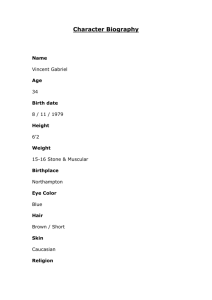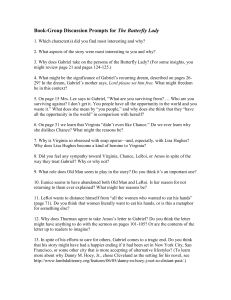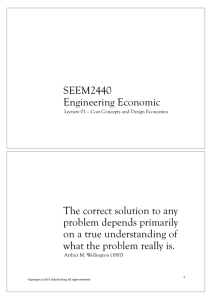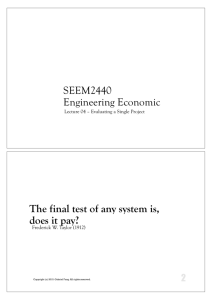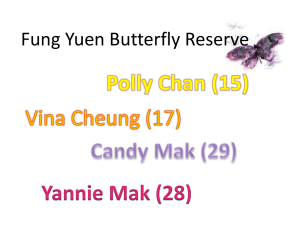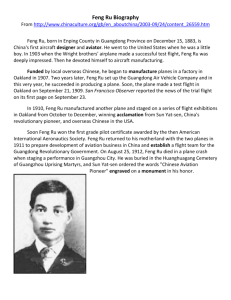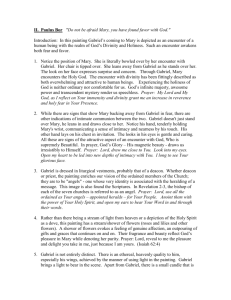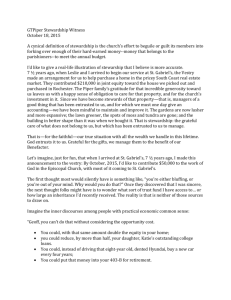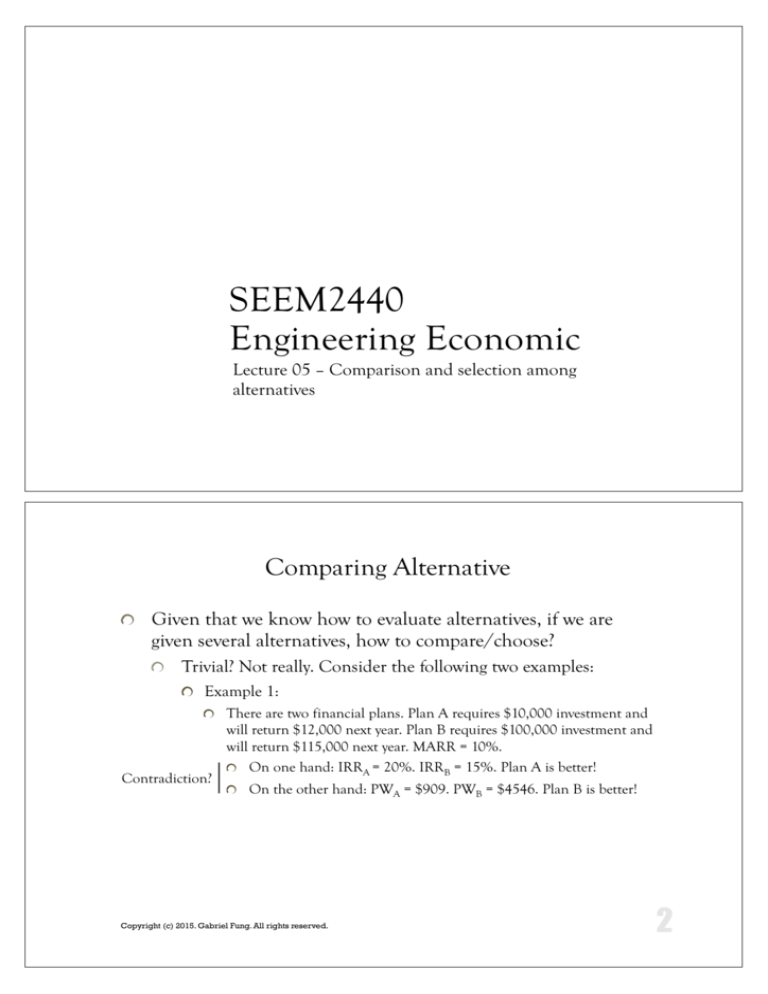
SEEM2440
Engineering Economic
Lecture 05 – Comparison and selection among
alternatives
Comparing Alternative
Given that we know how to evaluate alternatives, if we are
given several alternatives, how to compare/choose?
Trivial? Not really. Consider the following two examples:
Example 1:
There are two financial plans. Plan A requires $10,000 investment and
Contradiction?
will return $12,000 next year. Plan B requires $100,000 investment and
will return $115,000 next year. MARR = 10%.
On one hand: IRRA = 20%. IRRB = 15%. Plan A is better!
On the other hand: PWA = $909. PWB = $4546. Plan B is better!
Copyright (c) 2015. Gabriel Fung. All rights reserved.
Comparing Alternative
Example 2:
There are two financial plans. Plan A requires $350 investment and
How to make a
fair comparison?
will return $1,200 after 4 years. Plan B requires $500 investment and
will return $4,200 after 10 years. MARR = 10%.
On one hand: PWA = $469. PWB = $1119. Plan B is better!
On the other hand: The period is different! We can invest the
money obtained from Plan A to other project!
Copyright (c) 2015. Gabriel Fung. All rights reserved.
An Overview
In general, we have the following rules
Use either the Equivalent Worth Method or Incremental
Investment Analysis for ranking the alternatives.
We will discuss what is Incremental Investment Analysis shortly.
Do not use the IRR to compare the project directly.
Compare the alternatives using the same study period.
Copyright (c) 2015. Gabriel Fung. All rights reserved.
Two Investment Plans
Consider the following two plans:
Plan A:
You have to invest $73,000 now, and you will obtain $26,225 every
year for 4 years.
Plan B:
You have to invest $60,000 now, and you will obtain $22,000 every
year for 4 years.
Assume that your MARR is 10%. Which plan should you
choose (you can choose only one of them)?
Note: PW(10%)A = $10,131, PW(10%)B = $9,738, IRRA=17.3,
IRRB=16.3,
Copyright (c) 2015. Gabriel Fung. All rights reserved.
Two Investment Plans (cont’d)
Note that:
Copyright (c) 2015. Gabriel Fung. All rights reserved.
Two Investment Plans (cont’d)
Analysis using Equivalent Worth Method:
Rank the Investment Cost of the alternatives in ascending order.
Investment of Plan B < Plan A. So, Plan B is in a higher rank.
Compute the equivalent worth of the first alternative (Plan B):
PW(10%)B = $9,738
Since, PW(10%)B > 0. Plan B is chosen as the Base Alternative.
Base alternative would be automatically selected unless the extra
investment for the other plan is justified.
continued on next page…
Copyright (c) 2015. Gabriel Fung. All rights reserved.
Two Investment Plans (cont’d)
… continued from previous page
Compute the differences between the cash flows of the two
alternatives in the next rank.
Let D(A – B) be such cash flow (pls. refer to the next slide)
Compute the equivalent worth of the cash flow D(A – B).
PW(10%)D(A – B) = $393
Since, PW(10%)D(A – B) > 0 , the extra investment cost ($13,000)
is justified.
Thus, Plan A is being chosen as the base alternative now instead of
Plan B
Copyright (c) 2015. Gabriel Fung. All rights reserved.
Two Investment Plans (cont’d)
For the extra investment cost:
Plan A
$26,225
0
1
2
Plan D(A – B)
Plan B
$22,000
3
4
–
$60,000
$4,225
0
1
2
3
4
$73,000
=
0
1
2
3
4
$13,000
Thus, the additional investment cost ($13,000) has a present
value of $393.
Note that:
PW(10%)A = $10,131
PW(10%)B = $9,738
PW(10%)D(A – B) = PW(10%)A – PW(10%)B
Copyright (c) 2015. Gabriel Fung. All rights reserved.
More about Equivalent Worth Method
In short, Equivalent worth method can be done simply by…
1. Compute the equivalent worth (present worth, future worth or
annual worth) of the alternatives.
2. Rank the alternatives according to their equivalent worth in a
descending order.
Copyright (c) 2015. Gabriel Fung. All rights reserved.
Incremental Investment Analysis
We can do a similar kind of analysis, but using “Rate” instead
of “Equivalent Worth”. This is known as Incremental
Investment Analysis.
Copyright (c) 2015. Gabriel Fung. All rights reserved.
Two Investment Plans Again
Incremental Investment Analysis:
Rank the Investment Cost of the alternatives in ascending order:
Investment of Plan B < Plan A. So, Plan B is in a higher rank.
Compute the IRR of the first alternative (Plan B)
IRRB = 17.3%.
Since IRRB > MARR, Plan B is chosen as the base alternative.
Compute the differences between cash flows of the two
alternatives in the highest rank:
Let D(A – B) be such cash flow.
Continued on next page…
Copyright (c) 2015. Gabriel Fung. All rights reserved.
Two Investment Plans Again (cont’d)
… continued from previous page
Compute the IRR of the cash flow D(A – B).
IRRD(A – B) = 11.4%
Since, IRRD(A – B) > MARR, the extra investment cost ($13,000)
spent on Plan A is justified.
Thus, Plan A is being chosen as the base alternative now instead of
Plan B
Copyright (c) 2015. Gabriel Fung. All rights reserved.
Two Investment Plans Again (cont’d)
Question:
Can we compare the IRR of Plan A and Plan B directly in the
Incremental Investment Analysis but not the IRR of D(A – B)?
Just similar to the Equivalent Worth Analysis.
Answer:
Impossible!!!
IRRA = 16.3%
IRRB = 17.3%
Accordingly, Plan B is chosen
Contradictory with the previous analysis
If we based our decision on IRR solely, we will make a wrong
decision.
Copyright (c) 2015. Gabriel Fung. All rights reserved.
Two Investment Plans Again (cont’d)
See the following diagram as well
Present Worth ($)
10,131
9,738
393
10.0
11.4
16.3
i (%)
17.3
Plan B
MARR
Plan A
Copyright (c) 2015. Gabriel Fung. All rights reserved.
Incremental Investment Analysis
For the incremental investment analysis, can we use ERR
instead of IRR for evaluating the rate of return of the
incremental investment?
Sure! Why not?
Copyright (c) 2015. Gabriel Fung. All rights reserved.
Unequal Useful Life
So far, most problems that we encountered has a “life”:
E.g. The two financial plans in the previous example have a
“life” of 4 years.
We call such “life” as “useful life”.
Very often, the useful life of the alternatives are different.
E.g. Plan A will generate $1,200 after 4 years. Plan B will
generate $4,200 after 10 years. Which plan is better?
Copyright (c) 2015. Gabriel Fung. All rights reserved.
Unequal Useful Life Comparison
If the alternatives can be repeated:
We find the least common divisor of the two alternatives as a
reference, and repeat the alternatives
Plan A
Plan B
2 years
3 years
Repeat Plan A three times
Repeat Plan B two times
Copyright (c) 2015. Gabriel Fung. All rights reserved.
2 years
3 years
2 years
2 years
3 years
Unequal Useful Life Comparison
If the alternatives cannot be repeated:
The longest useful life among the two alternatives is chosen as
reference. We re-invest the capital at the MARR for the
remaining periods of the alternative that has a shorter useful
life.
Known as Coterminated Assumption
Plan A
Plan B
2 years
3 years
Plan A
Plan B
2 years
Reinvest at the MARR
3 years
Copyright (c) 2015. Gabriel Fung. All rights reserved.
Two More Investment Plans
Consider the following two plans:
Plan C:
You have to invest $3,500 now, and you will obtain $1,225 every
year for 4 years.
Plan D:
You have to invest $5,000 now, and you will obtain $1,480 every
year for 6 years.
Assume that your MARR is 10%. Which plan should you
choose (you can choose either one of them)?
Copyright (c) 2015. Gabriel Fung. All rights reserved.
Two More Investment Plans (cont’d)
Assume both projects are repeatable.
The least common multiple of the useful lives of Plan C and
Plan D is 12 years.
Thus, we try to repeat the cash flows until 12 years reached.
For example, for Plan C
Plan C
Plan C with 3 cycles
$1,225
$1,225
0
0
1
2
3
4
$3,500
1
$3,500
2
3
4
$3,500
5
6
7
8
9
10
11
$3,500
Copyright (c) 2015. Gabriel Fung. All rights reserved.
Two More Investment Plans (cont’d)
Equivalent Worth Method:
PW(10%)C = $1,028
PW(10%)D = $2,262
So, Plan D is better.
Note that instead of computing PW, we should better compute
AW (Why?)
AW(10%)C = $151
AW(10%)D = $332
Copyright (c) 2015. Gabriel Fung. All rights reserved.
12
Two More Investment Plans (cont’d)
Assumption of repeatability is failed. Coterminated
assumption is taken.
We reinvest all of the money into the firm’s MARR until the
end of the study period.
Plan C
$1,225
0
1
2
3
4
$3,500
Copyright (c) 2015. Gabriel Fung. All rights reserved.
Two More Investment Plans (cont’d)
Equivalent Worth Method:
PW(10%)C = $478
PW(10%)D = $1,446
So, Plan D is better.
Note that instead of computing PW, we should better compute
FW (Why?)
FW(10%)C = $847
FW(10%)D = $2,561
Copyright (c) 2015. Gabriel Fung. All rights reserved.
Useful Life Versus Study Period
Sometimes, the study period is different from the Useful Life.
E.g. I want to buy a printer for my project. There are two
printers with different printing capabilities, which last for 10
and 8 years. I will complete my project after 6 years, and I will
no longer use the printer. Which printer should I buy?
If the study period is greater than the useful life:
We may use the repeatability method or coterminated method
to solve the problem.
If the study period is less than the useful life:
We have to use the imputed market value to solve the problem.
Copyright (c) 2015. Gabriel Fung. All rights reserved.
Imputed Market Value
Also known as “implied market value”.
An estimation of the market value of a piece of asset when the
useful life of the asset is less then the study period.
Let T be the study period and L be the useful life, where T < L.
Imputed Market value is based on the sum of the following
two parts:
MVT = (PW of the remaining Capital Recovery Amounts at T)
+ (the Market value at L discount back to T)
Copyright (c) 2015. Gabriel Fung. All rights reserved.
Capital Recovery Amount
For each period i (i = 1, 2, …, N) in the study period, it is the
amount, Ai, from the capital investment that will be spent on
the asset (e.g., an equipment), such that A1 = A2 = … = An.
Conceptually, it is the “annual cost” of the capital invested.
Mathematically:
CR(i %) = I (A | P, i %, N) – S (A | F, i %, N)
where I is the initial capital investment
S is the salvage value (market value)
Copyright (c) 2015. Gabriel Fung. All rights reserved.
An Equipment
A photocopying machine has useful life 9 years. Its market
value at the end of its useful life will be $5,000. Its current
price is $47,600. Assume that MARR is 20%. If we want to buy
this machine and use it for T=5 years, what is its imputed
market value?
Copyright (c) 2015. Gabriel Fung. All rights reserved.
An Equipment (cont’d)
Answer:
First, compute the PW of the Capital Recovery Amount at T:
PW(20%)CR = [$47600 (A|P, 20%, 9) – $5000(A|F, 20%, 9)] (P | A
20%, 4) = $29,949
Second, compute the PW of the market value at T:
PW(20%)MV = $5,000 (P | F, 20%, 4) = $2,412
The imputed market value at T is:
MV5 = PWCR + PWMV = $32,361
Copyright (c) 2015. Gabriel Fung. All rights reserved.
Cost Only Alternative
We need to buy insurance for our employee! Which of the
following two financial plans is better?
$26,000
0
1
2
3
0
$38,100
1
2
$27,400
$39,100
$40,100
$380,000
Answer:
Since,
PW(10%)1 = –$477,077
PW(10%)2 = –$463,607
So, the decision is…
Copyright (c) 2015. Gabriel Fung. All rights reserved.
$415,000
3
Incremental Investment
Suppose we got six mutually exclusive projects as follows:
A
Investment
Revenue
B
C
D
E
F
$1,500
$900
$5,000
$2,500
$4,000
$7,000
$276
$150
$1,125
$400
$925
$1,425
Which one is preferable? Suppose MARR is 10% and study
period is 10 years.
Copyright (c) 2015. Gabriel Fung. All rights reserved.
Incremental Investment (cont’d)
Answer:
Rank the alternatives according to their investment cost:
B
A
D
E
C
F
Investment
$900
$1,500
$2,500
$4,000
$5,000
$7,000
Revenue
$150
$276
$400
$925
$1,125
$1,425
Compute their IRR:
IRR
B
A
10.6%
13.0%
D
9.6%
E
C
F
19.1%
18.3%
15.6%
Since IRRD = 9.6% < MARR, we reject Project D immediately.
Continued on next page…
Copyright (c) 2015. Gabriel Fung. All rights reserved.
More about Incremental Investment (cont’d)
…Continued from previous page
Compute the IRR of the incremental investment:
B
D(A – B)
D(E – A)
D(C – E)
D(F – C)
Investment
$900
$600
$2,500
$1,000
$2,000
Revenue
$150
$126
$649
$200
$300
10.6%
16.4%
22.6%
15.1%
8.1%
Justifiable?
Y
Y
Y
Y
N
Base Alternative
B
A
E
C
C
Next Alternative
A
E
C
F
--
IRR
Copyright (c) 2015. Gabriel Fung. All rights reserved.
Reconstruction
The owner of a downtown parking lot now determine whether
it would be financially attractive to construct an office building
on the site now being used for parking:
Investment Net Revenue
P. Keep existing parking lot, but improve
$200,000
$22,000
B1. Construct one-story building
4,000,000
600,000
B2. Construct two-story building
5,50,000
720,000
7,500,000
960,000
B3. Construct three-story building
The study period is 15 years. For each plan, the property has an
estimated market value that is equal to 50% of the investment
cost. Comment on which plan is the best if the MARR is 10%.
Copyright (c) 2015. Gabriel Fung. All rights reserved.
Reconstruction (cont’d)
By using the Equivalent worth method:
PW(10%)B1 = $1,042,460
PW(10%)B2= $590,727
PW(10%)B3 = $699,606
Copyright (c) 2015. Gabriel Fung. All rights reserved.
Reconstruction (cont’d)
By using the IRR method:
P
Investment
Net Revenue
Residual Value
B1
B2
B3
$200,000
$4,000,000
$5,550,000
$7,500,000
22,000
600,000
720,000
960,000
100,000
2,000,000
2,775,000
3,750,000
9.3%
13.8%
11.6%
11.4%
IRR
B1
Investment
Revenue
Residual Value
IRR
Justifiable?
Baseline Alternative
Copyright (c) 2015. Gabriel Fung. All rights reserved.
D (B2 – B1)
D(B3 – B1)
$4,000,000
$1,550,000
$3,500,000
600,000
120,000
360,000
2,000,000
755,000
1,750,000
13.8%
5.5%
8.5%
Y
N
N
B1
B1
B1

